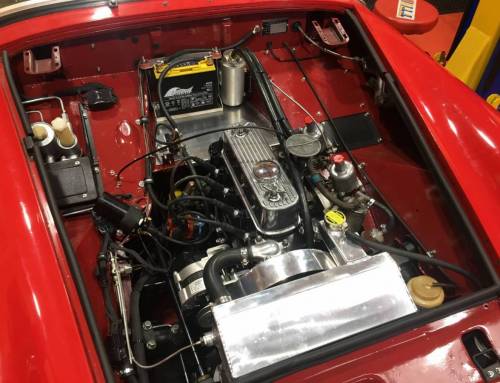After checking Plugs, Points and Timing, and removing & checking air cleaners, start by:
- Removing the Dashpots and Pistons, and then equalise the needle lengths by ‘walking’ them next to each other, after setting one with the shoulder flush with the base.
- Cleaning the inside of the dashpot and edge of the piston.
- Separating the Butterfly – throttle shaft joiner, so that they are independent, and then undoing each idle speed screw until both off the seat, then screw in one turn each as a starting point.
- Undo the Float Bowl tops, invert, dismantle the float levers and check the seat of the ‘needle’ for wear, and wear of the pivot rod and lever, and that the floats do not contain fuel..
- Also at this time, check the fuel level in each bowl to see if the same. Re-adjust float levers (as per Manual) to the correct clearances (7/16 or 1/8). Reassemble.
- Check for correct centreing of the Brass Jet in the centre of the base of each Carby – and check for wear / ovality of the jet hole. Adjust or Replace if worn (as per Manual).
- Wind up the Nut below the Jet, to raise it to its fully up position, and then wind each nut down 2 Full Turns to get a starting position.
- Reassemble and fit Dashpots and Pistons, lift to top, let drop. Both should hit the bottom at the same time with a ‘clunk’.
- Add a small amount of light oil into the tops of the dashpots as per Manual (10-20w or Sowing machine oil, or AQTF) and refit plunger.
- Start engine, and use say, a 1/2 inch hose at your ear, to listen to the induction hiss at the same spot (& angle) at each carby throat. Adjust the Idle screws to get the same ‘hiss’ from each carby.
- Adjust each idle screw equally to set idle to about 1000 rpm. Check hiss at each throat.
- Lift a Piston off its seat using the lifting rod below the Dashpot. (if no rod, use a screwdriver in throat to lift piston up 1/32 inch). If that carby mixture is correct, the revs should increase slightly and then drop back a bit. If the engine speeds up considerably, then that carby is too rich. If the revs drop considerably, then that carby is too weak. Adjust Mixture nut to suit (Up to weaken, and down to enrich the carby).
- Adjust the second Carby mixture in the same way.
- Recheck both the Induction “Hiss” on each carby. as well as the mixture again.
- Re-join both butterfly shafts together, and Reset the idle speed (as per manual) or to desired level.
- Replace air cleaners and test on the road. Re-adjust as necessary.
NB 1 Worn Butterfly Shafts will weaken mixtures, and worn Jets and/or Needles will enrichen mixtures.
NB 2 If the engine is modified by changing camshaft timing, valve sizes or compression etc., then an alternative ‘needle’ with a suitable profile will need to be calculated and fitted to each piston. (A richer version of the same needle profile sometimes works here as a starting point). Owners who have carried out similar modifications could help with selections.
A Book of SU Needle Selections is available.
John Fowler
